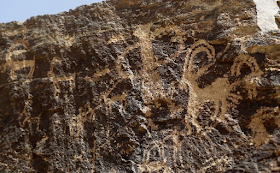Petroglyphs from Southern Iran. Dating: Second millennium BC (??? - estimate, no real data)...
As you can see, the predominant motif on the Dehtel petroglyphs is Ibex goat...Which is not surprising when we know that almost 90 percent of Iran's rock art consists of the ibex depictions!!!
The first ancient petroglyphs in Iran were discovered (recorded) in 2002 by Mohammed Naserifard in the hills outside the town of Khomein in central Iran.
He estimates that since the initial discovery in 2002 he travelled more than 700000 kilometres across two dozen Iranian provinces, unearthing some 50000 ancient paintings and engravings...Ibex after ibex after ibex...And few other things...

On the Bradshaw foundation site about Iran rock art we can read a short piece about Iranian ibex petroglyphs with a comment from Dr Mohammed Naserifard about their meaning...A very interesting comment indeed...About Ibex being linked to water...
Archaeological evidence shows that Ibex was hunted in Iran from the Middle Paleolithic period onwards. So pre people in the area knew the behavior and the lifecycle of this animal in detail...
They knew that the mating of Ibex goats happens every year at the same time...When the first rains arrive...In Oct/Nov...This is climatic chart for Western Iran...

So once the agriculture started in the region, the first farmers knew that the rains, needed for ploughing and sowing, arrive when Ibex goats start to mate...In Late Oct - Early Nov...
Which is why Ibex, with its curving horns and characteristic beard, went on to be incorporated into "decorative" friezes on painted pottery and they also appear on many stamp and cylinder seals from Neolithic, Chalcolithic, Bronze Age and Iron Age Iran...
Except these were anything but decorative motifs...These were religious symbols, "magic" animal calendar markers....For the most important annual event, the beginning of the rain season...
I talked about this in my post "Iranian goat of rain" Tepe Hissar pottery, "Strider", "Winged bull with Ibex horns", "Goat in a tree", "Jumping goat"...And many more...
Did people believe that it was the goat which brought the rain? I thinks so...Otherwise we would not see things like these:
Ibex-headed figure, possibly a human wearing the horns of an ibex, appears "in the guise of the master of animals" 🙂 in Iran from 4000BC...(Spoiler: there is no such thing as master of animals)
These two stamps, one from Arslan Tepe and one from Tepe Gawra, are very interesting. They both show Ibex, which we know was associated with the arrival of first autumn rains. But who is depicted with the Ibex goats? A man with an Ibex mask...Priest playing Ibex? Ibex god? Master of the animals? 🙂
Here is an Elamite figurine from around 3000BC, depicting a man with goat horns (or a goat horns helmet, cap)...
I talked about this in my post "Strider"...
Here is the interesting bit from Dr Mohammad Naserifard's text. He says that
...the symbolic and/or religious significance of the ibex in pre-Islamic Iran is unclear, although some argue that it was integral to a pre-Islamic creation narrative...
According to the Zoroastrian cosmogony, Mashya and Mashyana were the first man and woman whose procreation gave rise to the human race. According to Mohammad Naserifard, it was the ibex that was chosen as the symbol of divine assistance....
Where Ibex "may have represented an over-riding belief in, and request for, the provision of water, the guarantee of fertility and birth, and a Divine Hu, blessing and protection"...
Ha! Of course no explanation why would Ibex symbolize "provision of water"...
Ibex goat mating season starts Oct/Nov, with Ibex males, which are normally solitary, gather to fight for females...And then the rains arrive, provided by the Divine The Goat of Rain...
Pic: Elamite (South Iranian) seal with two male Ibex goats and a cross...
Anyway, if anyone knows Dr Mohammad Naserifard, can they ask him why he thought that Ibex was the symbol of Divine provision of water?
Finally, here are two seals from Susa Iran, dated to 4000BC and depicting a "goat-man" holding snakes.
BTW, something just occurred to me. You know how in Levant, Mot, the god of death was equated with the sun, which is symbolised by a snake, dragon...And how Devil is all about fire...And has a pet snake...And likes dressing up as a dragon...
Fun...
To read more about ancient animal and plant calendar markers, start here…then check the rest of the blog posts related to animal calendar markers I still didn't add to this page, and finally check my twitter threads I still didn't convert to blog post...I am 9 months behind now...




















No comments:
Post a Comment